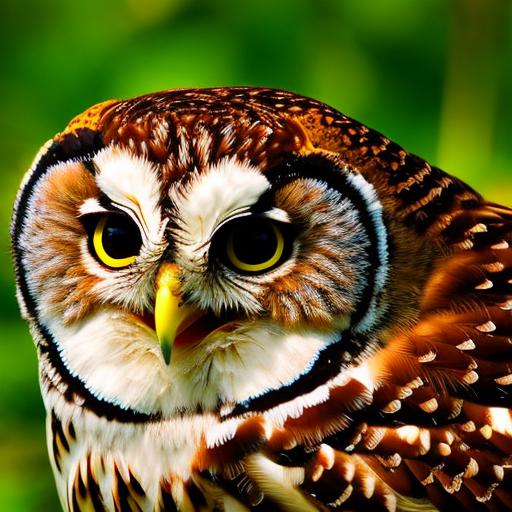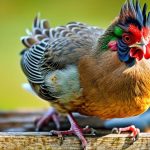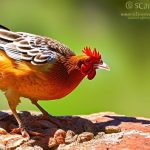Hawks attacking chickens can be a frustrating and costly problem for chicken owners. These majestic birds of prey can cause significant damage to a chicken coop and even kill or injure chickens. One possible solution to this problem is the use of fake owls. Fake owls are designed to mimic the presence of real owls, which are natural predators of hawks. In this article, we will explore the effectiveness of fake owls in deterring hawks from attacking chickens and discuss the factors to consider before using a fake owl.
Key Takeaways
- Hawks are a common predator of chickens and can cause significant damage to flocks.
- Owls can help keep hawks away from chicken coops by acting as a natural deterrent.
- Fake owls can also be effective in deterring hawks, but they have both pros and cons to consider.
- Factors to consider before using a fake owl include the size and type of owl, as well as proper placement.
- Other methods to keep hawks away from chicken coops include netting, fencing, and scare tactics.
Understanding the Problem of Hawks Attacking Chickens
Hawks are known to attack chickens for several reasons. One reason is that chickens are easy prey for hawks due to their small size and vulnerability. Hawks have sharp talons and beaks that they use to catch and kill their prey, and chickens make an easy target. Additionally, hawks are opportunistic hunters and will take advantage of any available food source, including chickens.
When hawks attack a chicken coop, they can cause significant damage. They may kill or injure multiple chickens in a single attack, leaving behind a trail of feathers and blood. This can be distressing for chicken owners who have invested time and money into raising their flock. Hawks can also cause stress and fear among the remaining chickens, which can affect their overall health and egg production.
The Role of Owls in Keeping Hawks Away
Owls are natural predators of hawks and can play a crucial role in keeping them away from chicken coops. Owls are nocturnal hunters and have excellent night vision, which allows them to spot and catch prey in low light conditions. Hawks, on the other hand, are diurnal hunters and are less active at night.
The presence of owls can deter hawks from attacking chickens because hawks see owls as potential threats. Hawks are territorial birds and will avoid areas where they believe there is a risk of encountering another predator. By placing a fake owl near a chicken coop, chicken owners can create the illusion that there is an owl present, which may deter hawks from approaching.
Fake Owls: How They Work
Fake owls are designed to mimic the appearance of real owls and create the illusion that there is a predator present. They are typically made of plastic or other lightweight materials and are often painted to resemble real owls. Some fake owls even have moving parts, such as rotating heads, to make them appear more lifelike.
There are different types of fake owls available on the market. Some are designed to be placed on a perch or pole, while others can be hung from a tree or other structure. Some fake owls are also equipped with reflective eyes or feathers that move in the wind to enhance their effectiveness.
The Pros and Cons of Using a Fake Owl
Using a fake owl to deter hawks from attacking chickens has several advantages. One of the main advantages is affordability. Fake owls are relatively inexpensive compared to other methods of predator control, such as netting or fencing. They are also easy to use and require minimal maintenance.
Another advantage of using a fake owl is that it does not harm the hawks or chickens. Unlike traps or poisons, which can be harmful to both predators and prey, fake owls simply create the illusion of a predator without causing any harm.
However, there are also some disadvantages to using a fake owl. One disadvantage is that hawks may eventually become accustomed to the presence of the fake owl and ignore it. This means that chicken owners may need to move the fake owl frequently to maintain its effectiveness.
Factors to Consider Before Using a Fake Owl

Before using a fake owl, there are several factors that chicken owners should consider. One important factor is the size of the chicken coop and the number of chickens. If the coop is large or there are a significant number of chickens, one fake owl may not be enough to deter hawks effectively. In this case, multiple fake owls may be needed.
The location of the chicken coop is also an important factor to consider. If the coop is located in an area with a high population of hawks, a fake owl may not be enough to keep them away. In these cases, additional measures such as netting or fencing may be necessary.
It is also important to consider the type of predators in the area. While hawks are a common threat to chickens, there may be other predators, such as foxes or raccoons, that also pose a risk. Chicken owners should assess the potential threats in their area and choose the appropriate predator control methods accordingly.
Choosing the Right Type of Fake Owl
When choosing a fake owl, it is important to consider the different types available and their features. Some fake owls are designed to be placed on a perch or pole, while others can be hung from a tree or other structure. The type of fake owl chosen will depend on the specific needs and preferences of the chicken owner.
It is also important to choose a fake owl that looks realistic. Hawks are intelligent birds and can quickly recognize if something is not right. A realistic-looking fake owl will be more effective in deterring hawks than one that looks obviously fake.
Proper Placement of the Fake Owl
The placement of the fake owl is crucial for its effectiveness in deterring hawks. It should be placed in a visible location near the chicken coop where hawks are likely to see it. Placing it on a perch or pole can make it more visible and increase its effectiveness.
However, it is important to note that hawks may eventually become accustomed to the presence of the fake owl if it remains in the same location for an extended period. To maintain its effectiveness, the fake owl should be moved frequently to create the illusion of a real owl that is actively patrolling the area.
Other Methods to Keep Hawks Away from Chicken Coops
While a fake owl can be an effective deterrent for hawks, it is important to use multiple methods for maximum effectiveness. Netting and fencing can be used in conjunction with a fake owl to create a physical barrier that prevents hawks from accessing the chicken coop.
Netting can be placed over the top of the chicken coop to prevent hawks from swooping down and attacking the chickens. Fencing can be used to create a perimeter around the coop, making it more difficult for hawks to access.
The Effectiveness of Fake Owls in Protecting Chickens from Hawks
In conclusion, fake owls can be an effective tool in deterring hawks from attacking chickens. By mimicking the presence of real owls, fake owls create the illusion of a predator and can deter hawks from approaching a chicken coop. However, it is important to consider all factors before using a fake owl, such as the size of the coop, the location, and the type of predators in the area.
While a fake owl can be an affordable and easy-to-use solution, it may not be enough on its own. Using additional methods such as netting or fencing can provide added protection for chickens. By using multiple methods in conjunction with a fake owl, chicken owners can maximize their chances of keeping hawks away and protecting their flock.
If you’re looking for ways to protect your chickens from hawks, you may have considered using a fake owl as a deterrent. While it may seem like a simple solution, there are some important factors to consider. According to a related article on PoultryWizard.com, it’s essential to understand the behavior of hawks and how they perceive threats. The article provides valuable insights into whether a fake owl can effectively keep hawks away from your chickens. To learn more about this topic, check out the article here.
FAQs
What is a fake owl?
A fake owl is a decoy bird that is designed to look like a real owl. It is often used as a scarecrow to deter birds and other animals from entering a certain area.
Will a fake owl keep hawks away from chickens?
There is no guarantee that a fake owl will keep hawks away from chickens. While hawks may be scared off by the sight of an owl, they are also intelligent birds and may quickly realize that the owl is not real.
What are some other ways to protect chickens from hawks?
Other ways to protect chickens from hawks include using netting or wire to cover the chicken coop or run, providing plenty of hiding places for the chickens, and keeping the chickens indoors during times when hawks are most active.
Are there any risks associated with using a fake owl?
There are no major risks associated with using a fake owl, but it is important to remember that it may not be effective in deterring hawks. Additionally, some birds may become accustomed to the presence of the fake owl and may no longer be scared of it.
Meet Walter, the feathered-friend fanatic of Florida! Nestled in the sunshine state, Walter struts through life with his feathered companions, clucking his way to happiness. With a coop that’s fancier than a five-star hotel, he’s the Don Juan of the chicken world. When he’s not teaching his hens to do the cha-cha, you’ll find him in a heated debate with his prized rooster, Sir Clucks-a-Lot. Walter’s poultry passion is no yolk; he’s the sunny-side-up guy you never knew you needed in your flock of friends!







